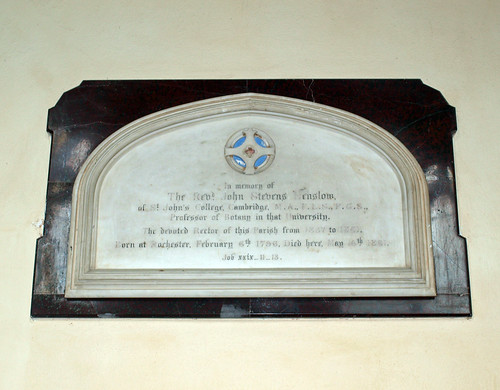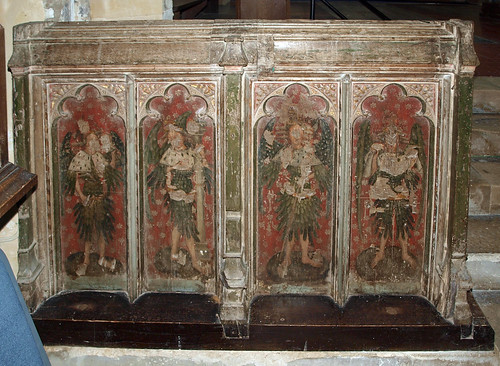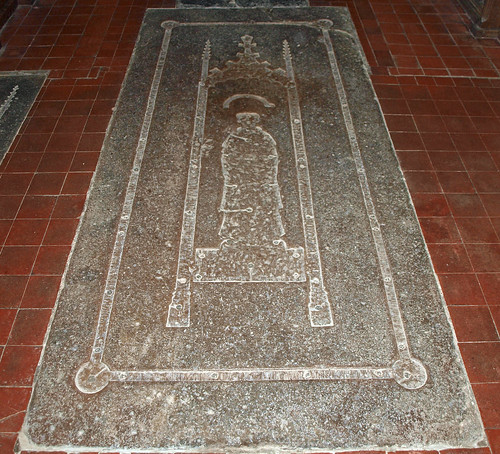ALL SAINTS. Quite large; at the far S end of the village. Nave with clerestory and aisles, W tower, S porch, and a chancel largely rebuilt in 1878. Its forms are Dec, and it probably was Dec. Vestry to its N, two-storeyed, Dec. N aisle doorway Dec, aisle windows Dec with segmental heads. Arcades of five bays with octagonal piers and double-chamfered arches. That also is probably C14. The clerestory has quatrefoil windows. Sturdy W tower with stair-turret not going externally to the top. W doorway with niches l. and r. Perp S porch with flushwork panelling. Entrance with motifs of crowns and lions and a niche over the arch. Perp S doorway of the same style with shields and crowns. Hood-mould on seated lions. Fine Perp lean-to roofs in the aisles with bosses. Fine roof in the nave alternating between double-hammerbeams and arched braces masquerading as hammerbeams. Against the lower hammer-beam ends big emblems such as roses, shields, a sun with crowns over. - SCREEN. Dado with eight painted figures, c. 1500. - SOUTH DOOR with tracery and a border of foliage trails. - PLATE. Two Flagons 1637; Cup and Paten 1639; Paten 1731.
HITCHAM. It has a fine 14th century church in a commanding position above the high road, with a beautifully panelled porch restored last century as a tribute to the distinguished botanist John Henslow. Here he ministered many years, and in this churchyard he sleeps. There is a stone to his memory in the chancel.
Within the porch is a door carved with a beautiful band of vines. At the top of it is some old tracery. The tower is 15th century, and the west doorway has a niche on either side. Over the nave is a 15th century hammerbeam roof with fine bosses, at the ends of the beams being monograms under crowns. There are a few bench-ends with rich poppyheads, a piscina with a very attractive canopy, and an inlaid vestry table made from a sounding-board. The lower part of the chancel screen is here still, with faint paintings in the panels of saints in ermine capes.
John Stevens Henslow, who was rector here, lives in the memory of all who honour Darwin, whose career he fixed. He was born at Rochester in 1796, and was devoted from childhood to the study of insects, shells, and minerals, becoming first a professor of minerals and then of botany at Cambridge. Darwin,who went up to Cambridge regarding Henslow with awe and veneration, found himself a favourite with the great man and chosen by him for special rambles, so that dons used to speak of Darwin as “the man who walks with Henslow.” Today we remember Henslow as the man who walked with Darwin.
But he did more than that; Henslow’s influence secured Darwin’s appointment to the Beagle, with consequences terrifying to the old scholar, who was appalled by the theory of the Origin of Species. He was passionately orthodox and told Darwin that it would be a great personal grief to him if even one word of the Thirty-Nine Articles were altered. But he was fair if he was fearful: he gave Darwin a copy of the revolutionary Lyall’s Principles to read, but implored him, while believing a little, by no means to believe all! Darwin at first detested geology, but Henslow inspired him, and in a month had him “working like a tiger” at it.
So far the great Professor Henslow whom all Europe knew; but there was Henslow the Hitcham parson, beloved of his parish. In spite of the opposition of the farmers here he started elementary schools from which arose first-rate naturalists. He founded benefit clubs, cricket and football clubs, allotments for landless parishioners, and annual shows at which he delivered delightful little lectures on the exhibits.
As at Cambridge with undergraduates and professors, so here he took his parishioners on rambles, into the fields and byways and to the cities. He taught Suffolk farmers the value of manures, and, having done that as a chemist, he went out as a geologist and found the precious deposits of phosphates in the Suffolk Crag, the bones and refuse of prehistoric monsters to make the fields of England fertile. He was a far-ranging Gilbert White, with interests greatly multiplied. Our foremost botanist, he helped to found the splendid museum at Ipswich when he was busy preparing models of the structures of fruit that were to gain him a medal at the Paris Exhibition; helping to form the museum at Kew, lecturing at Cambridge, presiding over sections of the British Museum, acting as Examiner in botany at London University, and generally living a dozen men’s lives. His memory should be cherished here, for he converted it from a lost and backward district to a model parish.
Within the porch is a door carved with a beautiful band of vines. At the top of it is some old tracery. The tower is 15th century, and the west doorway has a niche on either side. Over the nave is a 15th century hammerbeam roof with fine bosses, at the ends of the beams being monograms under crowns. There are a few bench-ends with rich poppyheads, a piscina with a very attractive canopy, and an inlaid vestry table made from a sounding-board. The lower part of the chancel screen is here still, with faint paintings in the panels of saints in ermine capes.
John Stevens Henslow, who was rector here, lives in the memory of all who honour Darwin, whose career he fixed. He was born at Rochester in 1796, and was devoted from childhood to the study of insects, shells, and minerals, becoming first a professor of minerals and then of botany at Cambridge. Darwin,who went up to Cambridge regarding Henslow with awe and veneration, found himself a favourite with the great man and chosen by him for special rambles, so that dons used to speak of Darwin as “the man who walks with Henslow.” Today we remember Henslow as the man who walked with Darwin.
But he did more than that; Henslow’s influence secured Darwin’s appointment to the Beagle, with consequences terrifying to the old scholar, who was appalled by the theory of the Origin of Species. He was passionately orthodox and told Darwin that it would be a great personal grief to him if even one word of the Thirty-Nine Articles were altered. But he was fair if he was fearful: he gave Darwin a copy of the revolutionary Lyall’s Principles to read, but implored him, while believing a little, by no means to believe all! Darwin at first detested geology, but Henslow inspired him, and in a month had him “working like a tiger” at it.
So far the great Professor Henslow whom all Europe knew; but there was Henslow the Hitcham parson, beloved of his parish. In spite of the opposition of the farmers here he started elementary schools from which arose first-rate naturalists. He founded benefit clubs, cricket and football clubs, allotments for landless parishioners, and annual shows at which he delivered delightful little lectures on the exhibits.
As at Cambridge with undergraduates and professors, so here he took his parishioners on rambles, into the fields and byways and to the cities. He taught Suffolk farmers the value of manures, and, having done that as a chemist, he went out as a geologist and found the precious deposits of phosphates in the Suffolk Crag, the bones and refuse of prehistoric monsters to make the fields of England fertile. He was a far-ranging Gilbert White, with interests greatly multiplied. Our foremost botanist, he helped to found the splendid museum at Ipswich when he was busy preparing models of the structures of fruit that were to gain him a medal at the Paris Exhibition; helping to form the museum at Kew, lecturing at Cambridge, presiding over sections of the British Museum, acting as Examiner in botany at London University, and generally living a dozen men’s lives. His memory should be cherished here, for he converted it from a lost and backward district to a model parish.



No comments:
Post a Comment